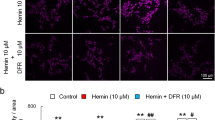Summary
Iron overload occurs in brain after intracerebral hemorrhage (ICH). Deferoxamine, an iron chelator, attenuates perihematomal edema and oxidative stress in brain after ICH. We investigated the effects of deferoxamine on cerebrospinal fluid (CSF) free iron and brain total iron following ICH.
Rats received an infusion of 100-µL autologous whole blood into the right basal ganglia, then were treated with either deferoxamine (100 mg/kg, i.p., administered 2 hours after ICH and then at 12-hour intervals for up to 7 days) or vehicle. The rats were killed at different time points from 1 to 28 days for measurement of free and total iron. Behavioral tests were also performed. Free iron levels in normal rat CSF were very low (1.1±0.4 µmol). After ICH, CSF free iron levels were increased at all time points. Levels of brain total iron were also increased after ICH (p<0.05). Deferoxamine given 2 hours after ICH reduced free iron in CSF at all time points. Deferoxamine also reduced ICH-induced neurological deficits (p<0.05), but did not reduce total brain iron.
In conclusion, CSF free iron levels increase after ICH and do not clear for at least 28 days. Deferoxamine reduces free iron levels and improves functional outcome in the rat, indicating that it may be a potential therapeutic agent for ICH patients.
Access this chapter
Tax calculation will be finalised at checkout
Purchases are for personal use only
Preview
Unable to display preview. Download preview PDF.
Similar content being viewed by others
References
Fish WW (1988) Rapid colorimetric micromethod for the quantitation of complexed iron in biological samples. Methods Enzymol 158: 357–364
Guo Y, Regan RF (2001) Delayed therapy of hemoglobin neurotoxicity. Acad Emerg Med 8: 510
Hammond EJ, Ramsay RE, Villarreal HJ, Wilder BJ (1980) Effects of intracortical injection of blood and blood components on the electrocorticogram. Epilepsia 21: 3–14
Hua Y, Schallert T, Keep RF, Wu J, Hoff JT, Xi G (2002) Behavioral tests after intracerebral hemorrhage in the rat. Stroke 33: 2478–2484
Hua Y, Keep RF, Hoff JT, Xi G (2003) Thrombin preconditioning attenuates brain edema induced by erythrocytes and iron. J Cereb Blood Flow Metab 23: 1448–1454
Huang F, Xi G, Keep RF, Hua Y, Nemoianu A, Hoff JT (2002) Brain edema after experimental intracerebral hemorrhage: role of hemoglobin degradation products. J Neurosurg 96: 287–293
Hurn PD, Koehler RC, Blizzard KK, Traystman RJ (1995) Deferoxamine reduces early metabolic failure associated with severe cerebral ischemic acidosis in dogs. Stroke 26: 688–694
Keberle H (1964) The biochemistry of desferrioxamine and its relation to iron metabolism. Ann NY Acad Sci 119: 758–768
Lee KR, Colon GP, Betz AL, Keep RF, Kim S, Hoff JT (1996) Edema from intracerebral hemorrhage: the role of thrombin. J Neurosurg 84: 91–96
Liachenko S, Tang P, Xu Y (2003) Deferoxamine improves early postresuscitation reperfusion after prolonged cardiac arrest in rats. J Cereb Blood Flow Metab 23: 574–581
Nakamura T, Keep R, Hua Y, Schallert T, Hoff J, Xi G (2004) Deferoxamine-induced attenuation of brain edema and neurological deficits in a rat model of intracerebral hemorrhage. J Neurosurg 100: 672–678
Nakamura T, Keep RF, Hua Y, Hoff JT, Xi G (2005) Oxidative DNA injury after experimental intracerebral hemorrhage. Brain Res 1039: 30–36
Nakamura T, Xi G, Park JW, Hua Y, Hoff JT, Keep RF (2005) Holo-transferrin and thrombin can interact to cause brain damage. Stroke 36: 348–352
Nilsson UA, Bassen M, Savman K, Kjellmer I (2002) A simple and rapid method for the determination of “free” iron in biological fluids. Free Radic Res 36: 677–684
Palmer C, Roberts RL, Bero C (1994) Deferoxamine posttreatment reduces ischemic brain injury in neonatal rats. Stroke 25:1039–1045
Prass K, Ruscher K, Karsch M, Isaev N, Megow D, Priller J, Scharff A, Dimagl U, Meisel A (2002) Desferrioxamine induces delayed tolerance against cerebral ischemia in vivo and in vitro. J Cereb Blood Flow Metab 22: 520–525
Regan RF, Panter SS (1993) Neurotoxicity of hemoglobin in cortical cell culture. Neurosci Lett 153: 219–222
Sadrzadeh SM, Anderson DK, Panter SS, Hallaway PE, Eaton JW (1987) Hemoglobin potentiates central nervous system damage. J Clin Invest 79: 662–664
Siesjo BK, Agardh CD, Bengtsson F (1989) Free radicals and brain damage. Cerebrovasc Brain Metab Rev 1: 165–211
Willmore LJ, Sypert GW, Munson JV, Hurd RW (1978) Chronic focal epileptiform discharges induced by injection of iron into rat and cat cortex. Science 200: 1501–1503
Willmore LJ, Rubin JJ (1982) Formation of malonaldehyde and focal brain edema induced by subpial injection of FeCl2 into rat isocortex. Brain Res 246: 113–119
Wu J, Hua Y, Keep RF, Nakamura T, Hoff JT, Xi G (2003) Iron and iron-handling proteins in the brain after intracerebral hemorrhage. Stroke 34: 2964–2969
Xi G, Keep RF, Hoff JT (1998) Erythrocytes and delayed brain edema formation following intracerebral hemorrhage in rats. J Neurosurg 89: 991–996
Xi G, Reiser G, Keep RF (2003) The role of thrombin and thrombin receptors in ischemic, hemorrhagic and traumatic brain injury: deleterious or protective? J Neurochem 84: 3–9
Xi G, Fewel ME, Hua Y, Thompson BG, Hoff J, Keep R (2004) Intracerebral hemorrhage: pathophysiology and therapy. Neurocrit Care 1: 5–18
Author information
Authors and Affiliations
Editor information
Editors and Affiliations
Rights and permissions
Copyright information
© 2006 Springer-Verlag
About this paper
Cite this paper
Wan, S., Hua, Y., Keep, R.F., Hoff, J.T., Xi, G. (2006). Deferoxamine reduces CSF free iron levels following intracerebral hemorrhage. In: Hoff, J.T., Keep, R.F., Xi, G., Hua, Y. (eds) Brain Edema XIII. Acta Neurochirurgica Supplementum, vol 96. Springer, Vienna. https://doi.org/10.1007/3-211-30714-1_43
Download citation
DOI: https://doi.org/10.1007/3-211-30714-1_43
Publisher Name: Springer, Vienna
Print ISBN: 978-3-211-30712-0
Online ISBN: 978-3-211-30714-4
eBook Packages: MedicineMedicine (R0)




